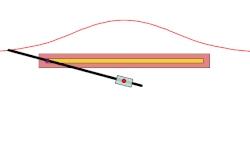

In geometry, a conchoid is a curve derived from a fixed point O, another curve, and a length d. It was invented by the ancient Greek mathematician Nicomedes. [1]


In geometry, a conchoid is a curve derived from a fixed point O, another curve, and a length d. It was invented by the ancient Greek mathematician Nicomedes. [1]
For every line through O that intersects the given curve at A the two points on the line which are d from A are on the conchoid. The conchoid is, therefore, the cissoid of the given curve and a circle of radius d and center O. They are called conchoids because the shape of their outer branches resembles conch shells.
The simplest expression uses polar coordinates with O at the origin. If
expresses the given curve, then
expresses the conchoid.
If the curve is a line, then the conchoid is the conchoid of Nicomedes .
For instance, if the curve is the line x = a, then the line's polar form is r = a sec θ and therefore the conchoid can be expressed parametrically as
A limaçon is a conchoid with a circle as the given curve.
The so-called conchoid of de Sluze and conchoid of Dürer are not actually conchoids. The former is a strict cissoid and the latter a construction more general yet.